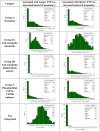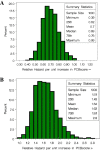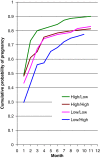A cohort study evaluation of maternal PCB exposure related to time to pregnancy in daughters
- PMID: 23962309
- PMCID: PMC3766643
- DOI: 10.1186/1476-069X-12-66
A cohort study evaluation of maternal PCB exposure related to time to pregnancy in daughters
Abstract
Background: Polychlorinated biphenyls (PCBs) remain ubiquitous environmental contaminants. Developmental exposures are suspected to impact reproduction. Analysis of mixtures of PCBs may be problematic as components have a complex correlation structure, and along with limited sample sizes, standard regression strategies are problematic. We compared the results of a novel, empirical method to those based on categorization of PCB compounds by (1) hypothesized biological activity previously proposed and widely applied, and (2) degree of ortho- substitution (mono, di, tri), in a study of the relation of maternal serum PCBs and daughter's time to pregnancy.
Methods: We measured PCBs in maternal serum samples collected in the early postpartum in 289 daughters in the Child Health and Development Studies birth cohort. We queried time to pregnancy in these daughters 28-31 years later. We applied a novel weighted quantile sum approach to find the bad-actor compounds in the PCB mixture found in maternal serum. The approach includes empirical estimation of the weights through a bootstrap step which accounts for the variation in the estimated weights.
Results: Bootstrap analyses indicated the dominant functionality groups associated with longer TTP were the dioxin-like, anti-estrogenic group (average weight, 22%) and PCBs not previously classified by biological activity (54%). In contrast, the unclassified PCBs were not important in the association with shorter TTP, where the anti-estrogenic groups and the PB-inducers group played a more important role (60% and 23%, respectively). The highly chlorinated PCBs (average weight, 89%) were mostly associated with longer TTP; in contrast, the degree of chlorination was less discriminating for shorter TTP. Finally, PCB 56 was associated with the strongest relationship with TTP with a weight of 47%.
Conclusions: Our empirical approach found some associations previously identified by two classification schemes, but also identified other bad actors. This empirical method can generate hypotheses about mixture effects and mechanisms and overcomes some of the limitations of standard regression techniques.
Figures




Similar articles
-
Prenatal polychlorinated biphenyl exposure is associated with decreased gestational length but not birth weight: archived samples from the Child Health and Development Studies pregnancy cohort.Environ Health. 2012 Jul 20;11:49. doi: 10.1186/1476-069X-11-49. Environ Health. 2012. PMID: 22817616 Free PMC article.
-
The associations of prenatal exposure to dioxins and polychlorinated biphenyls with neurodevelopment at 6 Months of age: Multi-pollutant approaches.Environ Res. 2022 Jun;209:112757. doi: 10.1016/j.envres.2022.112757. Epub 2022 Jan 20. Environ Res. 2022. PMID: 35065939 Free PMC article.
-
Prenatal exposure to polychlorinated biphenyls (PCBs) and polybrominated diphenyl ethers (PBDEs) may influence birth weight among infants in a Swedish cohort with background exposure: a cross-sectional study.Environ Health. 2013 May 31;12:44. doi: 10.1186/1476-069X-12-44. Environ Health. 2013. PMID: 23724965 Free PMC article.
-
Environmental exposure to polychlorinated biphenyls (PCBs) and dioxins. Consequences for longterm neurological and cognitive development of the child lactation.Adv Exp Med Biol. 2000;478:271-87. Adv Exp Med Biol. 2000. PMID: 11065080 Review.
-
The Duisburg birth cohort study: influence of the prenatal exposure to PCDD/Fs and dioxin-like PCBs on thyroid hormone status in newborns and neurodevelopment of infants until the age of 24 months.Mutat Res. 2008 Jul-Aug;659(1-2):83-92. doi: 10.1016/j.mrrev.2007.11.002. Epub 2007 Nov 12. Mutat Res. 2008. PMID: 18093869 Review.
Cited by
-
Associations between Fine Particulate Matter Components, Their Sources, and Cognitive Outcomes in Children Ages 9-10 Years Old from the United States.Environ Health Perspect. 2024 Oct;132(10):107009. doi: 10.1289/EHP14418. Epub 2024 Oct 30. Environ Health Perspect. 2024. PMID: 39475730 Free PMC article.
-
Sex-specific associations between co-exposure to multiple metals and visuospatial learning in early adolescence.Transl Psychiatry. 2020 Oct 21;10(1):358. doi: 10.1038/s41398-020-01041-8. Transl Psychiatry. 2020. PMID: 33087698 Free PMC article.
-
Prenatal metal mixture concentrations and reward motivation in children.Neurotoxicology. 2022 Jan;88:124-133. doi: 10.1016/j.neuro.2021.11.008. Epub 2021 Nov 15. Neurotoxicology. 2022. PMID: 34793781 Free PMC article.
-
Early-Life Exposure to a Mixture of Phenols and Phthalates in Relation to Child Social Behavior: Applying an Evidence-Based Prioritization to a Cohort with Improved Exposure Assessment.Environ Health Perspect. 2023 Aug;131(8):87006. doi: 10.1289/EHP11798. Epub 2023 Aug 9. Environ Health Perspect. 2023. PMID: 37556305 Free PMC article. Review.
-
Assessing the contributions of metals in environmental media to exposure biomarkers in a region of ferroalloy industry.J Expo Sci Environ Epidemiol. 2019 Sep;29(5):674-687. doi: 10.1038/s41370-018-0081-6. Epub 2018 Oct 18. J Expo Sci Environ Epidemiol. 2019. PMID: 30337680 Free PMC article.
References
-
- Kezios KL, Liu X, Cirillio PM, Kalantzi OI, Wang Y, Petreas MX, Park JS, Bradwin G, Cohn BA, Factor-Litvak P. Prenatal polychlorinated biphenyl exposure is associated with decreased gestational length but not birth weight: archived samples from the Child Health and Development Studies pregnancy cohort. Environ Health. 2012;11:49. doi: 10.1186/1476-069X-11-49. - DOI - PMC - PubMed
-
- Govarts E, Nieuwenhuijsen M, Schoeters G, Ballester F, Bloemen K, de Boer M, Chevrier C, Eggesbo M, Guxens M, Kramer U, Legler J, Martinez D, Palkovicova L, Patelarou E, Ranft U, Rautio A, Petersen MS, Slama R, Stigum H, Toft G, Trnovec T, Vandentorren S, Weihe P, Kuperus NW, Wilhelm M, Wittsiepe J, Bonde JP. Birth weight and prenatal exposure to polychlorinated biphenyls (PCBs) and dichlorodiphenyldichloroethylene (DDE): a meta-analysis within 12 European Birth Cohorts. Environ Health Perspect. 2012;120:162–170. - PMC - PubMed
-
- Baird DD, Wilcox AJ, Weinberg CR. Use of time to pregnancy to study environmental exposures. Am J Epidemiol. 1986;124:470–480. - PubMed
Publication types
MeSH terms
Substances
Grants and funding
LinkOut - more resources
Full Text Sources
Other Literature Sources
Medical
Research Materials

